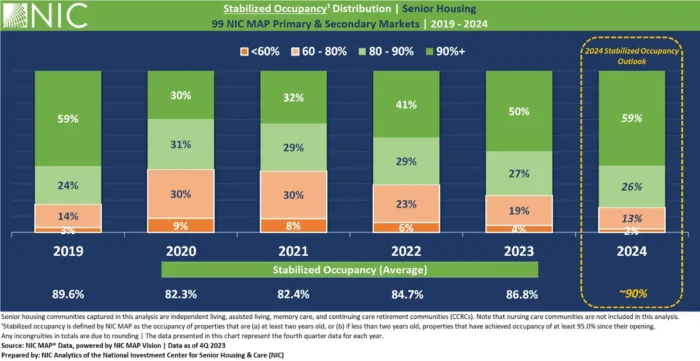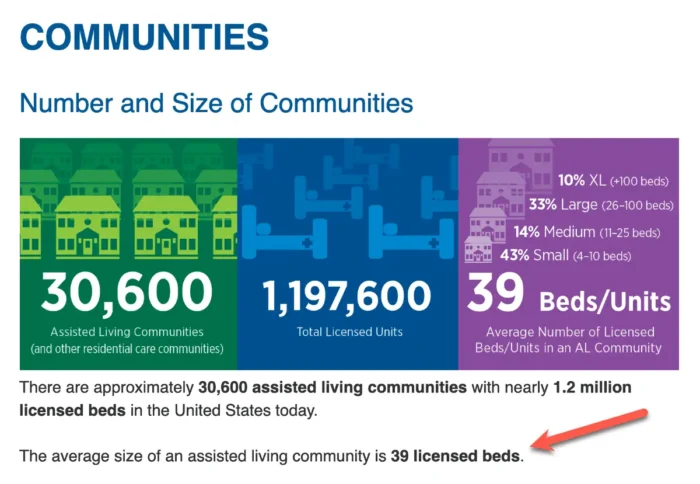In an era when the elderly are living longer and seeking more personalized care, starting a senior or assisted living facility or an assisted living facility has emerged as both a practical business opportunity and a way to make a significant difference in the lives of the aging population. This detailed guide is for entrepreneurs who are considering making their mark in the eldercare industry.
The senior living and assisted living sectors are witnessing increased demand and being reshaped by the growing need for innovative, person-centered care. When considering starting an assisted living business, you must understand the senior or assisted living market, legal requirements, and emotional touchpoints in branding. This can mean the difference between a viable venture and a facility destined to fall short.
The Current Landscape of Elderly Care
The Demographics Driving Demand
The aging demographic is on an upward trajectory globally, with the World Health Organization noting that the number of people aged 60 and above is expected to double by 2050, reaching 2.1 billion people. These figures illustrate a fundamental shift, highlighting the critical need for facilities that cater to the specific needs of the elderly.
According to the National Investment Center for Seniors Housing & Care (NIC), the average occupancy rate for senior housing is expected to be around 87% by the end of fourth quarter in 2024, which indicates a stable demand for these facilities.

Entrepreneurs must know these population dynamics and understand their demographic segment’s financial capacities and health expectations. For example, projections might suggest that there will be a surge in the number of affluent retirees who will seek high-end, luxury care experiences. Therefore, the first step towards starting a senior or assisted living facility is to comprehend who you will serve and what they will require from your establishment.
The Complexity of Elderly Needs
The senior living industry involves more than just providing a roof over one’s head. From independent living communities for active elders to seniors who need assisted living options and specialized memory care units, the spectrum of services required is vast and varied. Entrepreneurs need to identify the specific niches they aim to serve—the diseases common among their target group, the level of independence of the residents, and other personalized needs.
A comprehensive understanding of the distinct needs of your potential residents informs key decisions on staffing, facilities, and medical support services. Furthermore, this familiarity with the nuances of elderly care can enhance your business model by ensuring that all services are tailored to optimize residents’ quality of life.
Difference Between Senior Living and Assisted Living Facilities
Senior Living Facilities
Senior living facilities primarily focus on catering to the lifestyle needs of their residents, offering a combination of independence, community, and care. These facilities are designed for older adults who can manage their daily lives without constant supervision but seek convenience, social opportunities, and a sense of community.
Senior living facilities provide various services, such as housekeeping, meal preparation, maintenance, and extras like fitness centers, libraries, and social clubs. They are geared towards improving the quality of life, promoting active and healthy aging, and encouraging social connections among residents.
For example, many facilities organize group excursions, cultural events, and educational classes, allowing residents to find new interests and remain engaged in a supportive environment.
Assisted Living Facilities
Assisted living facilities are designed to bridge the gap between independent living and the need for more comprehensive care. These facilities focus on residents who require assistance with daily activities such as bathing, dressing, medication management, and mobility. The core mission of an assisted living facility is to provide a safe, supportive environment where residents can receive personalized care tailored to their unique needs.
Most assisted living facilities provide and prioritize the individual needs of each resident, ensuring they receive the right level of care and support for a dignified, independent lifestyle. These communities deliver personal care plans tailored to accommodate the varying degrees of assistance needed with daily living tasks. In addition to medical oversight, assisted living communities often offer a rich tapestry of social, recreational, and wellness activities designed to keep residents engaged and connected. Through a mix of professional and personal care and a nurturing environment, most assisted living communities strive to enrich the lives of their residents, offering peace of mind to both the individuals and their families.
As you can see, unlike more independent senior living facilities, assisted living communities often have medical professionals on staff, such as nurses and care assistants, to ensure that medical needs are promptly and effectively addressed. Additionally, these facilities typically offer a broader range of services to support the well-being of residents, including scheduled transportation, escort services to appointments, and regular wellness checks.
Inside most assisted living facilities, seniors can feel safe through 24-hour supervision, enjoy a vibrant community that combats loneliness and isolation, and access to care that adapts to changing health needs over time.
Foundations for Starting Successful Senior or Assisted Living Business
Create Your Business Plan as Your Roadmap
A solid business plan outlines the path from an idea to a fully operational facility. It starts with a thorough market analysis, looking at the expected growth in your region, the competitive landscape, and the gaps in services that your facility can fill.
Your plan should also include detailed financial projections covering the initial investment, operating costs, and revenue streams. There’s no substitute for precision here, as even small misjudgments can have profound implications for the viability and sustainability of your business. You can consider seeking advice from financial consultants specializing in the healthcare industry to ensure accuracy in their models.
Legal and Regulatory Requirements for Senior and/or Assisted Living Facilities
Entering the eldercare sector means becoming well-acquainted with many regulations and standards to ensure residents’ safety and well-being. Licensing requirements and permit applications can be complex and time-consuming, requiring many documents and proofs.
Compliance with legal regulations ensures the safety and well-being of residents while protecting your business against legal liabilities.
Senior living facilities primarily need licenses that affirm their capability to provide safe housing and basic care services. These licenses include property zoning permits, safety and health inspection approvals, and operational licenses specific to the state or country’s regulations governing such facilities.
Due to their medical and personal care services, assisted living facilities require a more complex set of licenses. In addition to the licenses required for senior living facilities, assisted living facilities must acquire health care provider licenses. This often involves proving staff qualifications, such as nursing certifications,
Permits serve as formal permissions for the facility’s operations, covering aspects from construction and renovation to complying with ADA (Americans with Disabilities Act) standards, fire safety, and environmental health. While both types of facilities require these basic permits, assisted living facilities face additional scrutiny. They might need permits that attest to the higher level of safety and accessibility necessary for residents requiring assistance with daily activities.
Furthermore, assisted living facilities must often demonstrate commitment to specific dietary regulations, medication management protocols, and emergency preparedness plans. This might involve obtaining permits linked to food service operations and pharmaceutical handling, which are generally not a requirement for senior living facilities focusing solely on independent living.
Each area has its own set of laws, and you’ll want to know these before settling on a location. Some things that you’ll want to look into are building codes, zoning requirements, and taxes. A lawyer will be especially helpful in this stage of the process, and by knowing the laws of the areas you are looking at, you can ultimately make a better choice about where to build your facility.
Engaging legal counsel with expertise in healthcare law will be indispensable. They can guide you through the complexities of state and federal regulations, ranging from building codes to legal documentation required for power of attorney and medical directives.
Startup Costs for Starting Senior or Assisted Living Facility
Starting a senior or assisted living facility is not only to open a business bank account, but it involves careful financial planning and awareness of the various startup costs. Here’s a breakdown of key startup costs that you should expect:
Real Estate Costs
Whether purchasing land to build on or acquiring an existing structure to renovate, real estate will represent a substantial portion of your initial costs. Location and size will heavily influence this expense.
The size will depend on the number of bed units you want to provide. For example, assisted living communities average around 39 licensed bad units, according to National Center for Assisted Living (NCAL) and American Health Care Association (AHCA). Smaller facilities often provide a more home-like environment, which can be a selling point for many residents.

Construction and renovation
Customizing the space to meet residents’ specific needs, including safety features, accessibility enhancements, and compliance with the Americans with Disabilities Act (ADA), can be costly.
Furnishings and equipment
Investing in high-quality, durable furnishings and specialized medical equipment is essential to support your residents’ health and comfort. This includes beds, seating, emergency call systems, and rehabilitation tools.
Also, you must have administrative and healthcare technology solutions, such as Electronic Health Records (EHR) systems, billing software, and security systems, requires a substantial upfront investment.
Licensing and permits
Obtaining the necessary licenses and permits is fundamental, with costs varying by location and the services offered. This may include healthcare provider licenses, safety inspection approvals, and zoning permits.
Staff recruitment and training
Building a skilled and compassionate team is central to the facility’s success. Costs here include recruitment, salaries, benefits, and ongoing training to ensure high-quality care. On average, each resident must receive about 3.5 hours per resident day from caregivers and nurses. Considering this information and the number of bed units you will have, you can quickly calculate how much nursing staff you will need.
You must understand and incorporate these costs into your business plan with detailed financial projections, which is crucial for securing funding and setting the stage for a successful senior and assisted living business.
Talk To Older People
The best way to know what older people want in their senior or assisted living communities is to talk to them. Find out what type of amenities they want, how they want their rooms set up, and what type of medical services are necessary for them. If you have recipes for dysphagia, include them in your brochures and marketing materials. With this inclusive approach, residents’ needs are addressed not just in terms of general preferences but also in terms of their specific needs.
All smart businesses will take feedback from their customers; in this instance, your customers are elders in that area. Conduct some surveys or hold a focus group to learn as much as possible from the older people nearby.
Design a Home, Not Just a Facility
Choose the Right Location for Opening a Senior Living Home
First, you must know where your senior or assisted living facility will run. You want to find a place that is large enough to hold everyone, has nearby attractions, and is not too close to another senior or assisted living community.
Location is one of the primary factors older people or their family members consider when deciding where to live, so it is important that you make a good decision here. You’ll want your place to be near things like parks and stores while also being a close commute for family members to visit.
Think about fostering a senior living community in which elderly or assisted living residents will thrive. Nearness to healthcare services, cultural centers, and recreational areas can significantly enrich their lives.
Explore all of your options before making a final decision.
However, the selection process isn’t solely about external conveniences. The neighborhood provides the backdrop for a facility’s culture, which is a critical aspect of this sector.
The Facility as an Enabler of Independence
Once you know where you are going to build your facility, you have to start thinking about the design. Every aspect of the facility needs to be planned out with older people in mind, from the size of the rooms to the facilities on-site to the decor.
As OZ Senior Living Architects puts it, your design should “reduce stress, increase comfort and safety, and enhance the quality of life for the senior population.” That is a lot to consider, so be sure you hire a good architecture firm with experience in senior housing.
Remember that your facility’s design impacts senior or assisted living residents’ lives more than you might imagine. Thoughtful layouts that encourage mobility and interaction, as well as the use of quality furnishings and assistive technology, can significantly enhance the living experience.
For example, the layout of communal areas directly affects social engagement opportunities, which are key to combating loneliness, a pervasive issue among seniors.
The Heart of Your Senior or Assisted Living Facility
Build Your Team Members
Your staff is the lifeblood of your facility. You can’t plan and run the entire senior or assisted living facility alone. You will have to hire some people to help you out, and it is essential that you find the right ones.
Each team member—from nurses to activities coordinators plays a key role in the senior or assisted living residents’ lives. A rigorous hiring process that emphasizes both qualifications and values is essential.
As we mentioned above, you’ll want a good architect to help with the planning and a lawyer to help with the local laws. On top of that, you’ll need staff to run the place – such as nurses for skilled nursing care (as we mentioned, if you build the assisted living facility, you will need skilled nursing facilities), maintenance staff, accountants, and tech support – and some people to help you design and furnish it. When conducting the hiring process, find people familiar with working with older people who can bring their expertise to the table.
Developing a culture that nurtures and supports staff is equally important. High turnover rates can disrupt the continuity of care and affect residents’ well-being. Investing in continuous training and providing a supportive work environment can lead to a dedicated team that forms the backbone of the facility’s reputation.
Services That Balance Care with Lifestyle
Modern senior and assisted living communities offer services adjusted to aged-related health needs and the desire for a fulfilling and active lifestyle. Nutrition programs, fitness centers, senior or assisted living communities, and recreational activities are often as crucial as medical care services.
You must be keen on innovation within senior or assisted living service offerings. You want your facility to keep up with the times, and the best way to do this is through research. All technology eventually becomes outdated, but installing the latest innovations in your facility can delay the need for upgrades for a while. Find out what new technologies are currently helping elders, and look for ways to integrate them into your facility planning.
For example, integrating smart home technologies can provide a sense of security while promoting independent living. Chronic disease management programs can also set a facility apart, giving prospective residents and their families peace of mind about their health management.
Always Keep Older People In Mind
Throughout this entire process, be sure to keep in mind the elders who will be living in your facility. Their needs are the most important thing and should influence almost every decision that you make. Following the tips above and focusing on providing the best experience possible for your older people, you’ll be off to a good start.
Your Branding and Marketing Strategy
The Essence of Branding in Senior or Assisted Living
Your brand is the story you want people to recognize your senior or assisted living facility by. What values do you hold? How engaging is your senior or assisted living community? What experiences do you offer?
These questions inform the narrative that you’ll want to be incorporated into all aspects of your marketing.
For example, do you differentiate your facility with a commitment to sustainability or a specialized therapy program for residents? Authentic storytelling that resonates with prospective residents and their family members creates a senior or assisted living community even before the doors open.
Attracting the Right Audience Through Marketing
Marketing a senior or assisted living facility isn’t only about selling a service but also about building trust. Family members searching for care for their loved ones are making a significant decision, often under emotionally trying circumstances.
Transparency about senior or assisted living cost they will need to pay for all the benefits for their loved inside assisted living communities, and empathy should be at the core of your marketing strategies. This can include open-door policies for facility tours or fostering a strong online presence with testimonials from current residents and families.
Balancing Compassion With Profits
Financial Considerations
Operating a senior or assisted living facility is, at its core, a business, and profitability is an essential consideration. This is not just about setting the right pricing structure but also about managing costs wisely.
When considering the pricing structure, you must analyze the financial power of the community where you select the location. The median monthly rate for a one-bedroom unit in an assisted living facility is $4,500, giving an idea of potential revenue per unit. Senior or assisted living costs vary between regions based on residence size and types of services needed, necessitating thorough analysis.
You must also predict future costs, such as upgrades to facility technology or regulatory changes, which is critical.
Multiple Revenue Streams for Stability
Diversifying your revenue streams can provide stability in a sector that is not immune to economic fluctuations. Beyond residential fees, consider offering additional services that tap into your team and facility’s specific skills and resources.
Think about in-house physical therapy services or meal plan provisions for residents who are transitioning to a more health-conscious regimen. Every extra service offered not only contributes to the bottom line but also improves the resident experience.
Conclusion
Starting a new assisted living facility is difficult, but it’s undoubtedly a noble adventure. From understanding the needs of your demographic to navigating the regulatory requirements, each step is critical in building a facility that serves not just as a place of residence but as a community center that enhances the lives of its members.
Following this guide will set you on the right path, but the real key to success is your commitment to the vision you set forth. It requires a combination of business skills and a compassionate heart that recognizes a well-run facility’s profound impact on the lives of the elderly and their families.
Remember, the essence of senior or assisted living facilities isn’t just about care; it’s about creating a haven where aging is an enriching and joyful part of life’s continuum.



